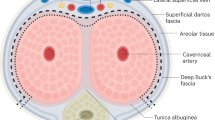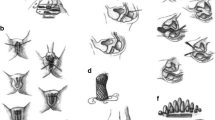Abstract
Purpose of Review
Gender-affirming vaginoplasty is associated with a high degree of patient satisfaction; however, transgender and gender diverse individuals may face significant challenges regarding sexual dysfunction postoperatively. Sexual function is complex and multifaceted, and data regarding postoperative sexual function can help guide patient counseling and decision-making.
Recent Findings
While much of the literature on outcomes of gender-affirming vaginoplasty has focused on capacity to achieve orgasm, numerous parameters of sexual function may impact patient satisfaction and quality of life. Patients may experience decrease in sexual desire and arousal following gender-affirming vaginoplasty; however, the impact of dysphoria vs additional psychosocial factors impacting sexuality vs organic sexual dysfunction remains unclear. Correlation of clitoral function with patient satisfaction is complex and not easily determined. Preoperative anorgasmia may predict postoperative anorgasmia; however, preoperative anorgasmia related to gender dysphoria and incongruence may resolve postoperatively.
Summary
While progress has been made in the literature surrounding gender-affirming vaginoplasty, existing limitations may make it difficult to appropriately counsel patients regarding surgical outcomes related to sexual health. Heterogeneity in study methodology and quality limits the ability to make specific recommendations regarding differences in technique, and there remains a significant need for high-quality, validated patient-reported outcome measures regarding sexual function post-gender-affirming vaginoplasty.
Similar content being viewed by others
References
Papers of particular interest, published recently, have been highlighted as: • Of importance •• Of major importance
Massie JP, et al. Predictors of patient satisfaction and postoperative complications in penile inversion vaginoplasty. Plast Reconstr Surg. 2018;141(6):911e–21e.
Cerwenka S, et al. Sexual behavior of gender-dysphoric individuals before gender-confirming interventions: a European multicenter study. J Sex Marital Ther. 2014;40(5):457–71.
Cerwenka S, et al. Intimate partnerships and sexual health in gender-dysphoric individuals before the start of medical treatment. Int J Sex Health. 2014;26:52–65.
Peitzmeier SM, et al. Intimate partner violence in transgender populations: systematic review and meta-analysis of prevalence and correlates. Am J Public Health. 2020;110(9):e1–14.
Coker AL. Does physical intimate partner violence affect sexual health?:a systematic review. Trauma Violence Abuse. 2007;8(2):149–77.
Kerckhof ME, et al. Prevalence of sexual dysfunctions in transgender persons: results from the ENIGI follow-up study. J Sex Med. 2019;16(12):2018–29.
Holmberg M, Arver S, Dhejne C. Supporting sexuality and improving sexual function in transgender persons. Nat Rev Urol. 2019;16(2):121–39.
Wiegel M, Meston C, Rosen R. The female sexual function index (FSFI): cross-validation and development of clinical cutoff scores. J Sex Marital Ther. 2005;31(1):1–20.
Huber S, et al. Development and validation of urological and appearance domains of the Post-Affirming Surgery Form And Function Individual Reporting Measure (AFFIRM) for transwomen following genital surgery. J Urol. 2021;206(6):1445–53. This article describes the development and validation of a novel patient-reported outcome questionnaire on postoperative outcomes and quality of life following gender-affirming vaginoplasty. The Post-Affirming Surgery Form and Function Individual Reporting Measure (AFFIRM ) is a 33-item PROM evaluating appearance and urologic and gynecologic symptomatology postoperatively. The authors describe the incorporation of input from members of the patient population seeking gender-affirming vaginoplasty. While there are limitations to the tool, including limited internal validity and the authors’ use of tools developed for cisgender to validate AFFIRM, this is an important first step in fostering equitable and inclusive care in this patient population.
Vedovo F, et al. Operated male-to-female sexual function index: validity of the first questionnaire developed to assess sexual function after male-to-female gender affirming surgery. J Urol. 2020;204(1):115–20.
Mandel A, et al. Development and validation of urological and appearance domains of the Post-Affirming Surgery Form and Function Individual Reporting Measure (AFFIRM) for transwomen following genital surgery. Letter J Urol. 2022;207(5):1162–3.
Roblee C, Horen SR, Jahromi AH. Commentary: physical, mental and sexual health among transgender women A comparative study among operated transgender and cisgender women in a national tertiary referral network. J Sex Med. 2021;18(8):1473–4.
Hess J, et al. Satisfaction with male-to-female gender reassignment surgery. Dtsch Arztebl Int. 2014;111(47):795–801.
Monteiro Petry Jardim LM, Cerentini TM, Lobato MIR, Costa ÂB, Cardoso da Silva D, Schwarz K, Vaitses Fontanari AM, Schneider MA, Rosito TE, La Rosa VL, Commodari E, Viana da Rosa P. Sexual function and quality of life in Brazilian transgender women following gender-affirming surgery: a cross-sectional study. Int J Environ Res Public Health. 2022;19(23):15773.
Zavlin D, et al. Male-to-female sex reassignment surgery using the combined vaginoplasty technique: satisfaction of transgender patients with aesthetic, functional, and sexual outcomes. Aesthetic Plast Surg. 2018;42(1):178–87.
Kloer C, et al. Sexual health after vaginoplasty: a systematic review. Andrology. 2021;9(6):1744–64. This systematic review of 140 studies spanning nearly 7000 patients focused on sexual health outcomes following gender-affirming vaginoplasty highlights the need for standardized and validated PROMs for this patient population. The most commonly utilized PROM in the studies evaluated was the Female Sexual Function Index (FSFI), a metric that has only been validated in the cisgender female population. The authors also highlight other limitations in the literature, including the lack of prospective studies and inclusive metrics when evaluating sexual function postoperatively, and offer a list of potential areas for researchers to focus their efforts to better meet the needs of TGD patients.
van der Sluis WB, et al. Long-term follow-up of transgender women after secondary intestinal vaginoplasty. J Sex Med. 2016;13(4):702–10.
Boas SR, et al. Outcomes and predictors of revision labiaplasty and clitoroplasty after gender-affirming genital surgery. Plast Reconstr Surg. 2019;144(6):1451–61.
Wierckx K, et al. Sexual desire in trans persons: associations with sex reassignment treatment. J Sex Med. 2014;11(1):107–18.
Elaut E, et al. Hypoactive sexual desire in transsexual women: prevalence and association with testosterone levels. Eur J Endocrinol. 2008;158(3):393–9.
Becker I, et al. A cross-sectional multicenter study of multidimensional body image in adolescents and adults with gender dysphoria before and after transition-related medical interventions. Arch Sex Behav. 2018;47(8):2335–47.
Cocchetti C, et al. Management of hypoactive sexual desire disorder in transgender women: a guide for clinicians. Int J Impot Res. 2021;33(7):703–9.
Sigurjónsson H, et al. Long-term sensitivity and patient-reported functionality of the neoclitoris after gender reassignment surgery. J Sex Med. 2017;14(2):269–73.
LeBreton M, et al. Genital sensory detection thresholds and patient satisfaction with vaginoplasty in male-to-female transgender women. J Sex Med. 2017;14(2):274–81.
Kwun Kim S, et al. Long-term results in patients after rectosigmoid vaginoplasty. Plast Reconstr Surg. 2003;112(1):143–51.
Morrison SD, et al. Long-term outcomes of rectosigmoid neocolporrhaphy in male-to-female gender reassignment surgery. Plast Reconstr Surg. 2015;136(2):386–94.
di Summa PG, et al. Colic-based transplant in sexual reassignment surgery: functional outcomes and complications in 43 consecutive patients. J Sex Med. 2019;16(12):2030–7.
Lawrence AA. Patient-reported complications and functional outcomes of male-to-female sex reassignment surgery. Arch Sex Behav. 2006;35(6):717–27.
Blasdel G, et al. Coming Soon: Ability to Orgasm After Gender Affirming Vaginoplasty. J Sex Med. 2022;19(5):781–8. This article retrospectively quantifies time to orgasm postoperatively in 199 patients undergoing robotic peritoneal flap vaginoplasty and found the majority (86%) of patients able to experience orgasm, with a median time to orgasm of 180 days. Interesting findings from this study include the lack of correlation between postoperative and preoperative orgasmic function and the association of smoking with postoperative anorgasmia. While this study is limited in that it is a single center, retrospective review, this recent study on postoperative outcomes regarding orgasmic function utilizing current surgical technique provides further evidence that gender-affirming vaginoplasty has a positive impact on patients’ sexual health and function.
Fan Chiang YH, et al. Smoking increases the risk of postoperative wound complications: a propensity score-matched cohort study. Int Wound J. 2023;20(2):391–402.
Harte CB, Meston CM. The inhibitory effects of nicotine on physiological sexual arousal in nonsmoking women: results from a randomized, double-blind, placebo-controlled, cross-over trial. J Sex Med. 2008;5(5):1184–97.
Garcia MM. Sexual function after shallow and full-depth vaginoplasty: challenges, clinical findings, and treatment strategies- urologic perspectives. Clin Plast Surg. 2018;45(3):437–46.
O’Dwyer C, Kumar S, Wassersug R, Khorrami A, Mukherjee S, Mankowski P, Genoway K, Kavanagh AG. Vaginal self-lubrication following peritoneal, penile inversion, and colonic gender-affirming vaginoplasty: a physiologic, anatomic, and histologic review. Sex Med Rev. 2023;11(3):212–23.
De Cuypere G, et al. Sexual and physical health after sex reassignment surgery. Arch Sex Behav. 2005;34(6):679–90.
Gentile G, Martino A, Nadalin D, Masetti M, Marta BL, Palmisano F, Franceschelli A, Stella P, Sanfelici AP, Brunocilla E, Colombo F. Penile-scrotal flap vaginoplasty versus inverted penile skin flap expanded with spatulated urethra: a multidisciplinary single-centre analysis. Arch Ital Urol Androl. 2020;92(3).
Klassen AF, et al. International phase I study protocol to develop a patient-reported outcome measure for adolescents and adults receiving gender-affirming treatments (the GENDER-Q). BMJ Open. 2018;8(10):e025435.
Hendrickx L, Gijs L, Enzlin P. Distress, sexual dysfunctions, and DSM: dialogue at cross purposes? J Sex Med. 2013;10(3):630–41.
Hendrickx L, Gijs L, Enzlin P. Sexual difficulties and associated sexual distress in Flanders (Belgium): a representative population-based survey study. J Sex Med. 2016;13(4):650–68.
Author information
Authors and Affiliations
Corresponding author
Ethics declarations
Conflict of Interest
The authors declare no competing interests.
Human and Animal Rights and Informed Consent
All reported studies/experiments with human or animal subjects performed by the authors were performed in accordance with all applicable ethical standards including the Helsinki Declaration and its amendments, institutional/national research committee standards, and international/national/institutional guidelines.
Additional information
Publisher’s Note
Springer Nature remains neutral with regard to jurisdictional claims in published maps and institutional affiliations.
Rights and permissions
Springer Nature or its licensor (e.g. a society or other partner) holds exclusive rights to this article under a publishing agreement with the author(s) or other rightsholder(s); author self-archiving of the accepted manuscript version of this article is solely governed by the terms of such publishing agreement and applicable law.
About this article
Cite this article
Wilder, S., Shannon, B., Blasdel, G. et al. Sexual Function Outcomes Following Gender-Affirming Vaginoplasty: a Literature Review. Curr Sex Health Rep 15, 301–306 (2023). https://doi.org/10.1007/s11930-023-00377-8
Accepted:
Published:
Issue Date:
DOI: https://doi.org/10.1007/s11930-023-00377-8




